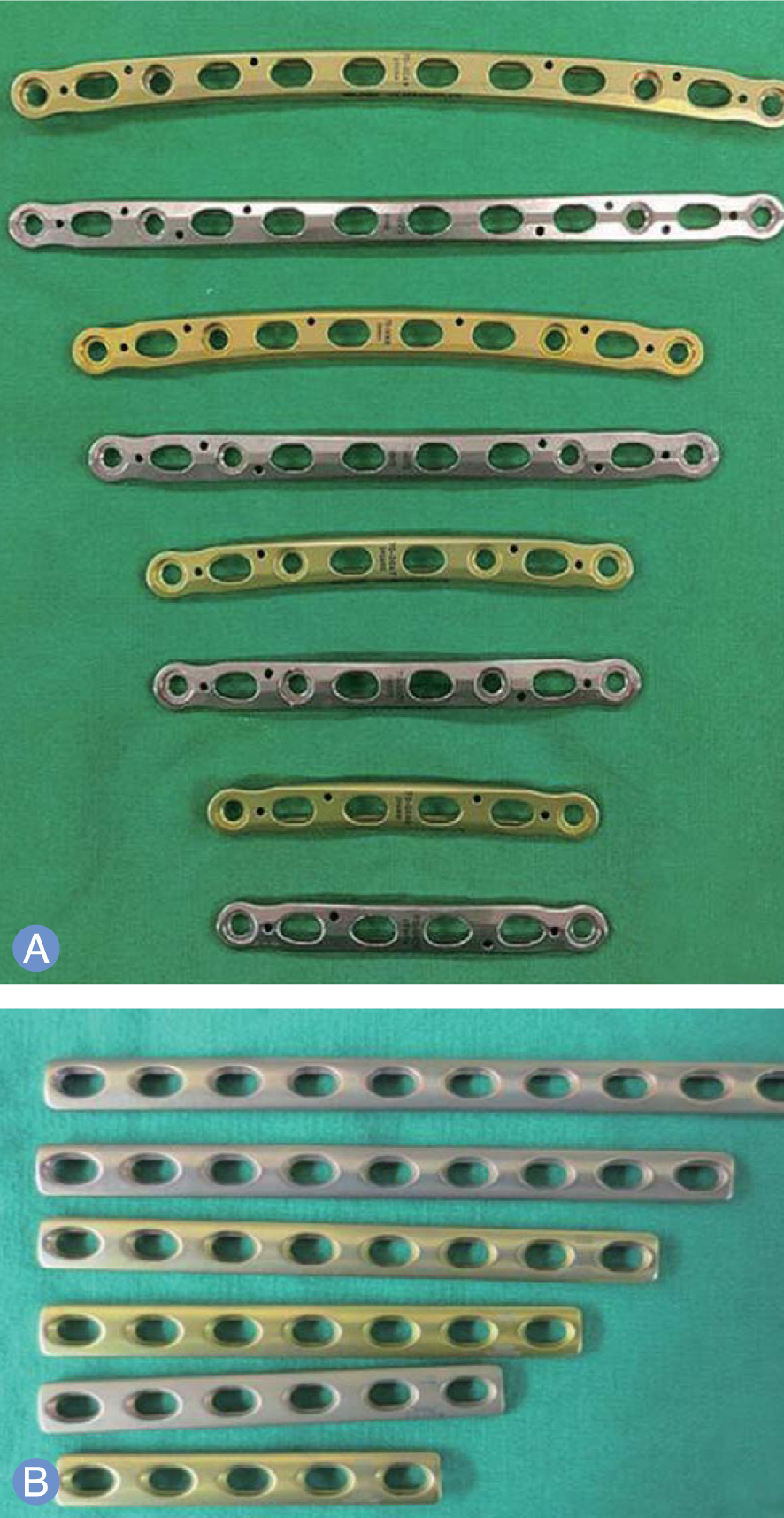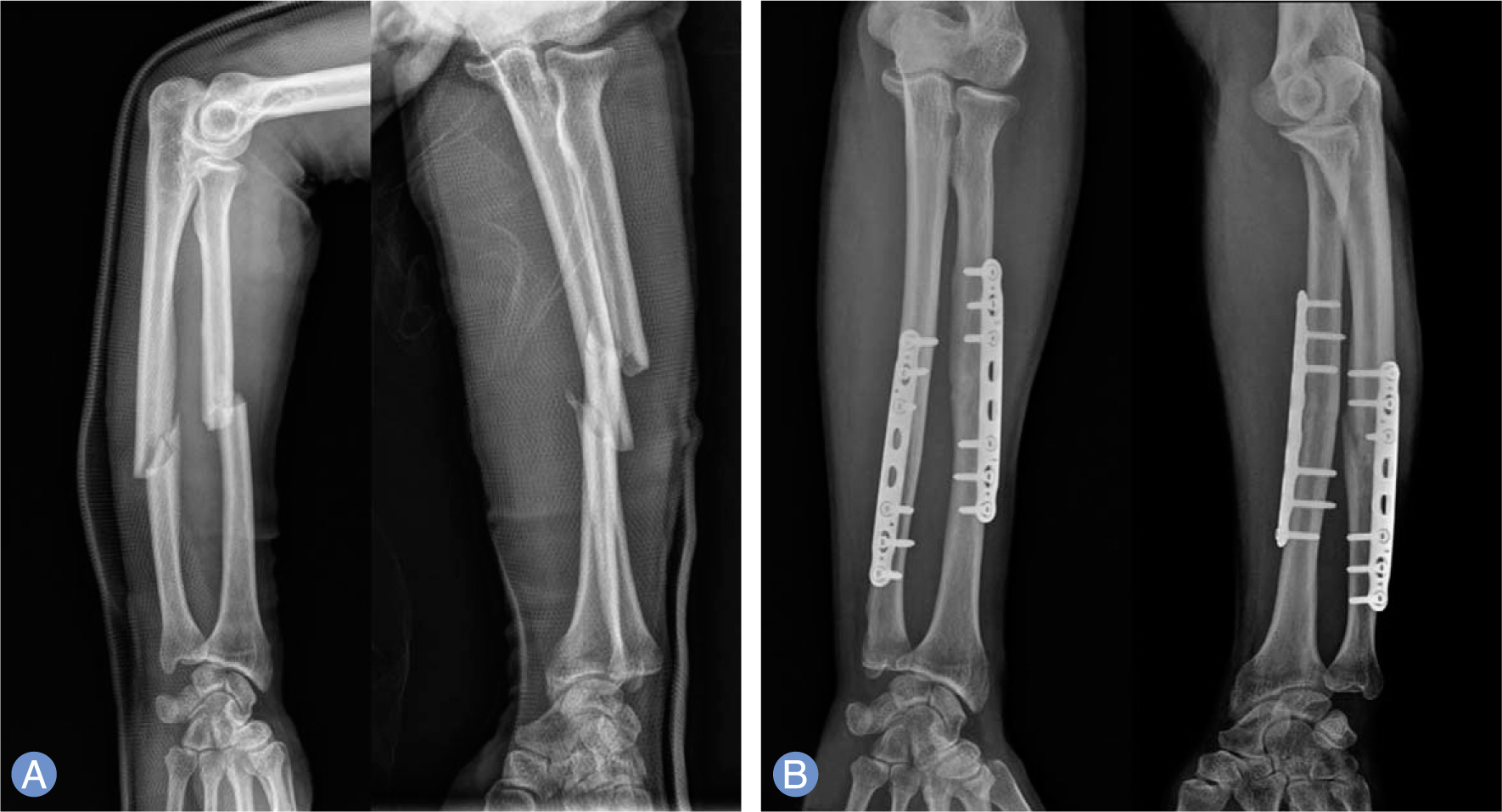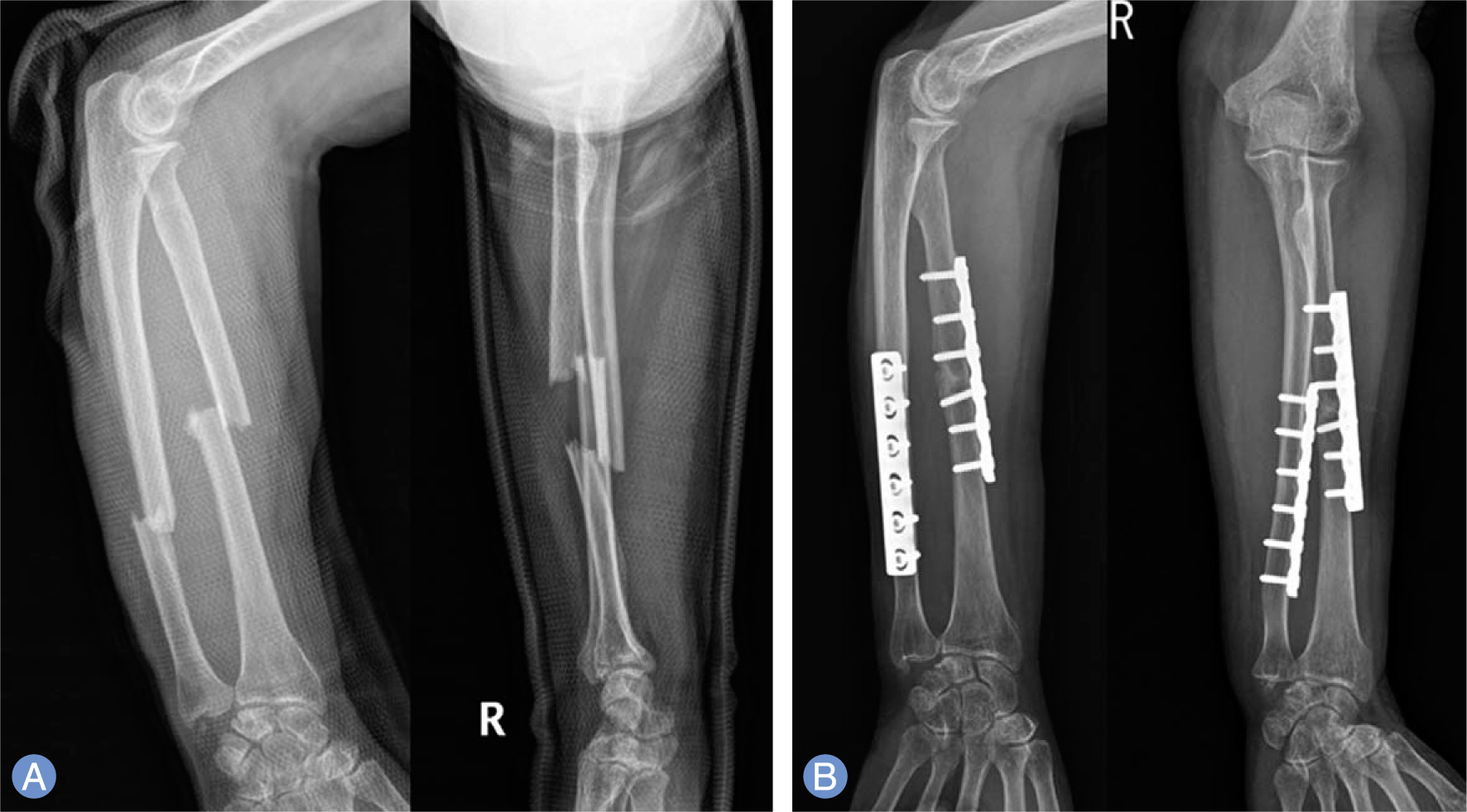J Korean Soc Surg Hand.
2015 Dec;20(4):168-175. 10.12790/jkssh.2015.20.4.168.
Comparison of Locking versus Dynamic Compression Plates for Treatment of Diaphyseal Forearm Fracture
- Affiliations
-
- 1Department of Orthopedic Surgery, Wonkwang University School of Medicine, Iksan, Korea. kanghongje@hanmail.net
- KMID: 2150398
- DOI: http://doi.org/10.12790/jkssh.2015.20.4.168
Abstract
- PURPOSE
To compare the clinical and radiologic outcomes of internal fixation using locking compression plate (LCP) or limited contact-dynamic compression plate (DCP) for patients with diaphyseal forearm fractures.
METHODS
Forty-four patients with diaphyseal forearm fractures treated with either LCP (22 patients) or DCP (22 patients) were compared in regards to clinical outcomes, range of motion and Grace and Eversmann criteria at the last follow-up. Union rate and mean time to radiological union were also compared depending on comminution.
RESULTS
Mean range of motion and Grace and Eversmann criteria between two groups did not show significant differences. Bony union was achieved in all patients. Although mean time to union was not different in simple fractures (15.5 weeks in LCP group vs. 13.8 weeks in DCP group), it was different between two groups in mutifragmentary fractures (14.8 weeks in LCP groups vs. 24 weeks in DCP group).
CONCLUSION
Internal fixation using both LCP and DCP for diaphyseal forearm fractures yield satisfactory clinical and radiologic outcomes. In multifragmentary fractures, LCP can shorten radiologic union time than using DCP.
Figure
Reference
-
References
1. Anderson LD, Sisk D, Tooms RE, Park WI 3rd. Compression-plate fixation in acute diaphyseal fractures of the radius and ulna. J Bone Joint Surg Am. 1975; 57:287–97.
Article2. Muller ME. Manual of internal fixation: techniques recommended by the AO Group. 2nd ed. Berlin; New York: Springer-Verlag;. 1979.3. Sage FP. Fractures of the shafts and distal ends of the radius and ulna. Instr Course Lect. 1971; 20:91–115.4. Sage FP. Medullary fixation of fractures of the forearm: a study of the medullary canal of the radius and a report of fifty fractures of the radius treated with a prebent triangular nail. J Bone Joint Surg Am. 1959; 41A:1489–516.5. Hughston JC. Fracture of the distal radial shaft; mistakes in management. J Bone Joint Surg Am. 1957; 39:249–64.6. Jeong SY, Moon U, Vim SJ, Yoon SR, Rah SK, Choi CU. Clinical comparison in intramedullary fixation to plate fixation on treatment of the both forearm bone fractures. J Korean Soc Fract. 1995; 8:893–901.
Article7. Park SW, Choi G. The operative treatment of the shaft fractures of the forearm bone. J Korean Soc Fract. 1995; 8:199–205.
Article8. Leung F, Chow SP. Locking compression plate in the treatment of forearm fractures: a prospective study. J Orthop Surg (Hong Kong). 2006; 14:291–4.
Article9. Kim JW, Kang HJ, No SH. Operative treatment of the displaced midshaft clavicle fracture using precon-toured locking compression plate. Clin Should Elbow. 2012; 15:117–22.
Article10. Muller ME. The comprehensive classification of fractures of long bones. Berlin; New York: Springer-Verlag;1990.11. Grace TG, Eversmann WW Jr. Forearm fractures: treatment by rigid fixation with early motion. J Bone Joint Surg Am. 1980; 62:433–8.12. Anderson LD. Treatment of ununited fractures of the long bones; compression plate fixation and the effect of different types of internal fixation on fracture healing. J Bone Joint Surg Am. 1965; 47:191–208.13. Shen WJ, Liu TJ, Shen YS. Plate fixation of fresh displaced midshaft clavicle fractures. Injury. 1999; 30:497–500.
Article14. Ring D, Jupiter JB. Ununited fractures of the clavicle with bony defect: treatment with corticocancellous interposition bone graft and plate fixation. Tech Hand Up Extrem Surg. 1999; 3:193–6.15. Perren SM. Minimally invasive internal fixation history, essence and potential of a new approach. Injury. 2001; 32(Suppl 1):SA1–3.16. Gardner MJ, Brophy RH, Campbell D, et al. The mechanical behavior of locking compression plates compared with dynamic compression plates in a cadaver radius model. J Orthop Trauma. 2005; 19:597–603.
Article17. Saikia K, Bhuyan S, Bhattacharya T, Borgohain M, Jitesh P, Ahmed F. Internal fixation of fractures of both bones forearm: comparison of locked compression and limited contact dynamic compression plate. Indian J Orthop. 2011; 45:417–21.
Article18. Stevens CT. ten Duis HJ. Plate osteosynthesis of simple forearm fractures: LCP versus DC plates. Acta Orthop Belg. 2008; 74:180–3.19. Fulkerson E, Egol KA, Kubiak EN, Liporace F, Kummer FJ, Koval KJ. Fixation of diaphyseal fractures with a segmental defect: a biomechanical comparison of locked and conventional plating techniques. J Trauma. 2006; 60:830–5.
Article20. Deluca PA, Lindsey RW, Ruwe PA. Refracture of bones of the forearm after the removal of compression plates. J Bone Joint Surg Am. 1988; 70:1372–6.
Article21. Park KC, Kim HS, Oh JH. Periprosthetic fracture after locked plating in the osteoporotic long bone fracture. J Korean Orthop Assoc. 2012; 47:222–6.
Article22. Bottlang M, Doornink J, Byrd GD, Fitzpatrick DC, Madey SM. A nonlocking end screw can decrease fracture risk caused by locked plating in the osteoporotic diaphysis. J Bone Joint Surg Am. 2009; 91:620–7.
Article
- Full Text Links
- Actions
-
Cited
- CITED
-
- Close
- Share
- Similar articles
-
- Treatment of Diaphyseal Fractures of the Forearm Bones
- Compression Plate Fixation in the Treatment of Diaphyseal Fractures of the Radius and Ulna
- Treatment of Diaphyseal Fractures of the Radius and Ulna with Dynamic Compression Plates: A Retrospective Study of 52 Fractures in 33 Patients
- Treatment of Diaphyseal Fractures of Forearm Both Bones: Comparison between Plate Fixation and Rush Pin Intramedullary Nailing
- Surgical Treatment of Diaphyseal Fractures of Both Forearm Bones in Adolescents




